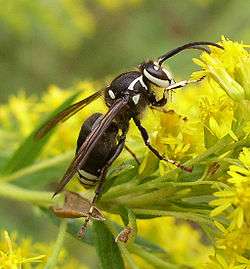Vespoidea
| Vespoidea | |
|---|---|
 | |
| Dolichovespula maculata, bald-faced hornet | |
| Scientific classification | |
| Kingdom: | Animalia |
| Phylum: | Arthropoda |
| Class: | Insecta |
| Order: | Hymenoptera |
| Infraorder: | Aculeata |
| Superfamily: | Vespoidea |
| Families | |
|
See text | |
Vespoidea is a superfamily of order Hymenoptera of class Insecta, although older taxonomic schemes may vary in this categorization, particularly in their recognition of a now-obsolete superfamily Scolioidea. The members of this group are known as wasps and ants.
Vespoid families
| Vespoid families | |||||||||||||||||||||||||||||||||||||||||||||||||||
| |||||||||||||||||||||||||||||||||||||||||||||||||||
| Phylogenetic relationships of vespoid families based on Brothers (1999)[1] |
- †Armaniidae[2] - "ant-like wasps"[3]
- Bradynobaenidae - bradynobaenid wasps
- Chyphotidae - chyphotid wasps
- Formicidae - ants
- Mutillidae - velvet ants/velvet wasps
- Myrmosidae - myrmosid wasps
- Pompilidae - spider wasps
- Rhopalosomatidae - rhopalosomatid wasps
- Sapygidae - sapygid wasps
- Scoliidae - scoliid wasps
- Sierolomorphidae - sierolomorphid wasps
- Thynnidae - thynnid wasps
- Tiphiidae - tiphiid wasps
- Vespidae - paper wasps, hornets, potter wasps, yellow jackets, and relatives
Phylogenetics
Newer research based on four nuclear genes (elongation factor-1α F2 copy, long-wavelength rhodopsin, wingless and the D2–D3 regions of 28S ribosomal RNA—2700 bp in total) suggests the higher-level relationships need to be changed, with Rhopalosomatidae as a sister group of the Vespidae and the clade Rhopalosomatidae + Vespidae as sister to all other vespoids and apoids. Additionally, superfamily Apoidea is found to be within the Vespoidea, suggesting the dismantling of Vespoidea (sensu lato) into many smaller superfamilies; Formicoidea, Scolioidea, Tiphioidea, Thynnoidea, and Pompiloidea in addition to a much more narrowly defined Vespoidea. Finally, families Mutillidae, Tiphiidae, and Bradynobaenidae were found to be paraphyletic.[4] Another recent study confirms the need for revision of high-level relationships, although the pattern of sister-group relationships within the putative Vespoidea matches the same basic pattern as the 2008 study, including a paraphyletic Bradynobaenidae and Tiphiidae.[5]
References
- ↑ Brothers, D.J. (1999). "Phylogeny and evolution of wasps, ants and bees (Hymenoptera, Chrysisoidea, Vespoidea, and Apoidea)". Zoologica Scripta. 28: 233–249. doi:10.1046/j.1463-6409.1999.00003.x.
- ↑ LaPolla, J.S.; Dlussky, G.M.; Perrichot, V. (2013). "Ants and the Fossil Record". Annual Review of Entomology. 58: 609–630. doi:10.1146/annurev-ento-120710-100600. PMID 23317048.
- ↑ Grimaldi, D.; Agosti, D.; Carpenter, J. M. (1997). "New and rediscovered primitive ants (Hymenoptera, Formicidae) in Cretaceous amber from New Jersey, and their phylogenetic relationships." (PDF). American Museum Novitates. 3208: 1–43.
- ↑ Pilgrim, E.; von Dohlen, C.; Pitts, J. (2008). "Molecular phylogenetics of Vespoidea indicate paraphyly of the superfamily and novel relationships of its component families and subfamilies". Zoologica Scripta. 37 (5): 539–560. doi:10.1111/j.1463-6409.2008.00340.x.
- ↑ Johnson, B.R.; et al. (2013). "Phylogenomics Resolves Evolutionary Relationships among Ants, Bees, and Wasps". Current Biology. 23 (20): 2058–2062. doi:10.1016/j.cub.2013.08.050. PMID 24094856.
External links
 Media related to Vespoidea at Wikimedia Commons
Media related to Vespoidea at Wikimedia Commons